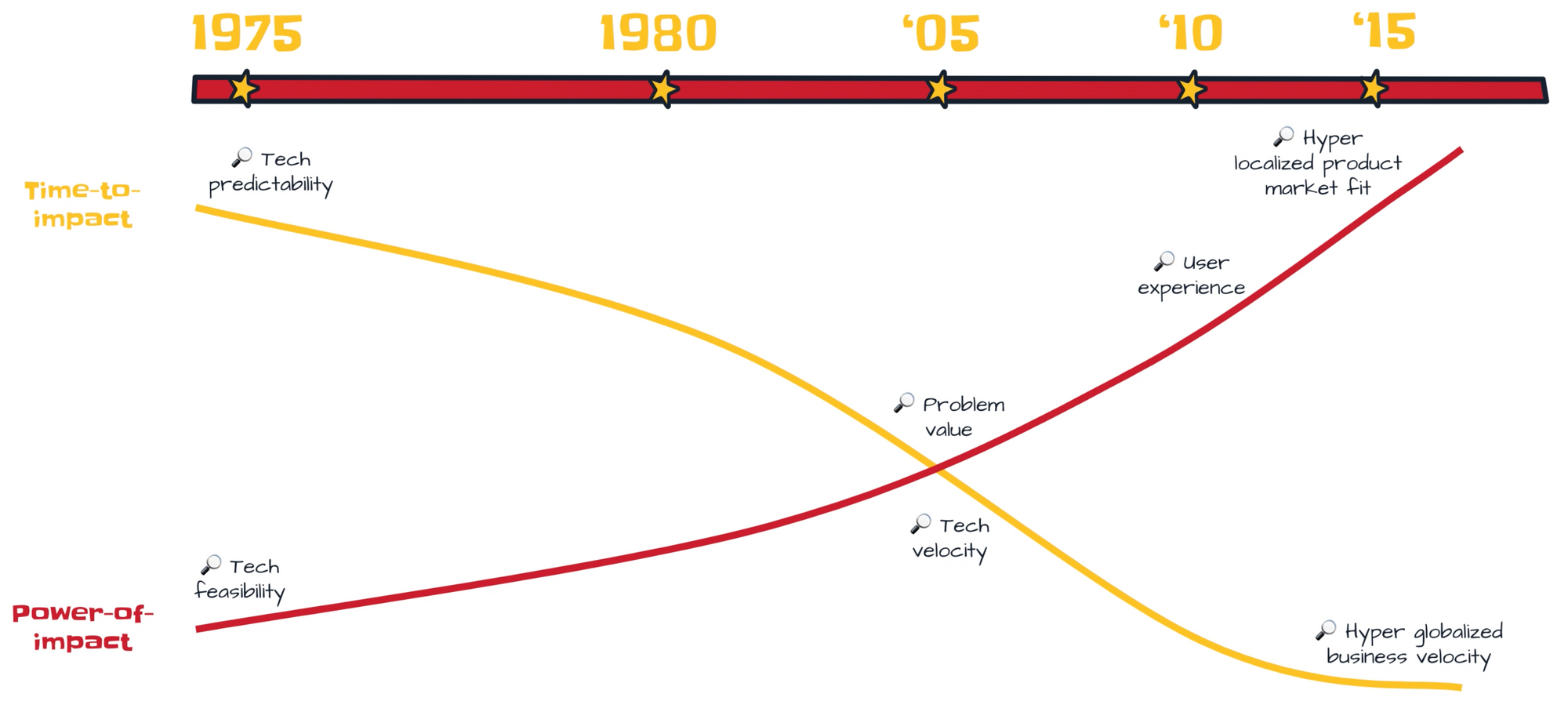Hybrid functions have recently made their appearance in tech companies. These new positions are shaping the future of digital product development, made faster by the versatility of contributors. They bear many names. We at PayFit chose to name them Product Builders.
Let’s take a look at the gradual emergence of hybrid product functions in companies.
The development impact drivers
As an introduction, here are two key indicators which are influencing the evolution of software development:
- "Power of impact", which is the value brought to users. This indicator has been increasing over time because product creators (Software Engineers, Product Managers and Product Designers) have shifted their attention from focusing only on tech feasibility. Indeed, problem value, then user experience and lately the ability to define hyper localized product market fit have dramatically improved the power of impact of software publishers.
- "Time to impact", which corresponds to the speed of iterations on the product in relation to changing needs. This one has dramatically decreased over the years because software publishers are not so much focusing on technical predictability anymore, but rather on velocity, to cope with the needs of the users

Each evolution in the software development world makes it possible to have a greater impact on these two indicators. The emergence of the Internet and the resulting SaaS model have completely changed the situation: software is becoming accessible everywhere, available to everyone, and can be built by everyone.
Time-to-impact and Power-of-impact are becoming the levers of success for the software and product world.
1975 - 2000: the emergence of digital workers
The software crisis
At the end of the 1960s, software engineering officially made its appearance. After having been confined since the 1950s to huge systems built for scientific calculations or industrial process control (in short, working behind the scenes), software engineering took on an existence of its own after the “software crisis” of 68-72: engineers were faced with an ever-growing computing power, ever more complex tasks to solve, and a lack of sustainable software development processes.
To solve this, they sought to build methods, tools and practices to produce software that could meet requirements and respect quality criteria as well as economic constraints. This led to NATO itself organizing the “Software Engineering Conferences” in 1968 and 1969. Already, the aim was to efficiently solve the many problems encountered in large-scale IT projects.
At the time, software products were built using methods such as the V-model or the Waterfall model. These models are now known to not be flexible: they do not allow for easy "roll back" if the user or the market is not satisfied – or has simply changed since the requirements were first written.
The software world was also very different. Customers signed multi-year contracts, with very high maintenance and service costs. The software itself was installed at the customers' premises, ran on their servers and was updated more or less regularly.
Until the 90s, two types of roles were sought for the creation of software: the computer developer, of course, and, very quickly, the project manager who was also able to make the link with the business by creating documents such as a Market Requirements Document (MRD) or a Product Requirements Document (PRD).
The birth of Agile
From the 90s onwards, new, lighter development methods emerged, including:
- the famous Scrum method (86-2001),
- Extreme Programming (96-99),
- and Feature-Driven Development (97-99).
They are all iterative and incremental development methods, in clear contrast to past models.
In 2001, the Agile Manifesto established the 12 principles of agility, the first of which being:
“Our highest priority is to satisfy the customer
through early and continuous delivery of valuable software.”
Eventually, “customer” came to mean “user”. With Agile development, the aim is no longer to only develop predictable and functional software, but also to be user-centric.
The Agile approach gave rise to a new role, that of Product Owner. In charge of defining the steps in the roadmap, he/she ensures that the delivered product meets the expectations of the market and the needs of the users, but also relies on those expectations and needs to allocate the resources available for development. He or she is in charge of providing business expertise to ensure that product development is in line with market needs.
The Cloud
Since 2000, the Internet is everywhere, and the SaaS model has grown exponentially.
Now sold as an on-demand service, software adopts a new economic model, such as monthly subscription. It becomes easily accessible via the Internet and the software publisher's servers.
The customer benefits from a more regularly-updated product, and can (in theory) stop the subscription at any time.
On the other hand, using a subscription without multi-year commitment allows (most of the time) to get rid of it quickly. The satisfaction of the user thus becomes truly key in the success of a product. Its development focuses on the user, her path, her needs, etc.
Software that cannot adapt to market needs or current trends is doomed to be supplanted by a large number of international and dematerialised competitors.
2000-2010: from product manager to product builder
2005 -2010: Arrival of product managers
Now that users are playing an increasingly important role in the construction of products, the role of the product manager is emerging to also deal with the strategic part of the product, i.e. to identify the customer's needs, the business impact for the publisher, etc.
If at first the PM missions were a little vague, today it is an essential position. An extremely powerful and important job, it has real commercial value and an impact on our two key indicators described at the start of this article.
There is no longer any question about the role or the career opportunities that come with being a Product Manager. We have moved from an abstract role to a real career path, well defined and very promising.
Even CEOs of several major players started out as product managers within their companies.
To name only two:
- Susan Wojcicki was the first Product Manager at Google AdSense, she is now the CEO of YouTube.
- Marissa Mayer was Product Manager at Google before becoming CEO of Yahoo.
2010 - 2015: Revenge of the product designers
From the 2000s onwards, the mobile revolution was underway, first with the Blackberry device and then of course the first iPhone in 2007. Nowadays, nearly 4 billion people use smartphones, and almost 4.5 billions use social networks. Internet access is becoming mobile and democratised. The need for immediacy and reactivity is ever more pressing.
The multiplication of users increases usage tenfold, and brings the need to adapt to users. They become more and more important in the creation of software, which allows certain positions to emerge.
The product designer role stands out as the one in charge of improving the user experience and ensuring optimal use of the product. They are truly the embodiment of the “Power of Impact” indicator.
At the same time, the "Lean" production method is developing. It works by iterations, and is capable of adapting software very quickly, in response to the user's feedback. Lean’s effectiveness is proven: the players with the best design performance increase their revenues at twice the rate of their counterparts in the sector. This explains why the number of product designers has increased dramatically in companies over the last 10 years.
Just like the product manager before, the product design profession, a hybrid of communication and digital professions, was becoming a career move in its own right.
2020 onward: Emergence of hybrid functions
These days, several major trends are clearly emerging within software publishers and tech companies.
Customising your product to find your product-market fit
There are two ways to adapt your product to what the market wants.
First, by adapting the product to local constraints.
The largest companies have experienced the importance of this. The example of the failure of Amazon or Google on the Chinese market, to the benefit of local competitors such as Alibaba and Baidu, is staggering. Without adapting to the local culture or consumption habits, they were unable to convince the market.
Second, by turning local customers into the creators of their own product.
For instance, Shopify helps entrepreneurs create their online business. It empowers them to create their own website. This way, the created online shops are more in line with local needs, and are therefore more successful.
As of today, 1.75 million entrepreneurs use Shopify, 10 times more than Amazon. Shopify is also present in 175 countries, whereas Amazon only has local sites in 21 countries. While Amazon is still the biggest earner, Shopify surpassed them in monthly unique visitors during the second quarter of 2021.
Supporting rapid international growth
Low-code applications are a type of development platform that allows complex business applications to be built and deployed quickly with minimal development effort, while still following best practices and respecting local laws.
Right now, Salesforce and Microsoft are already using their own low-code platforms.
At PayFit, we rely on JetLang. Initially just a custom-built programming language, it has gradually evolved into a true low-code platform. It is from this platform that we create the payroll part of our product: the interface, the calculations, the generation of documents, etc.
With our low-code platform, PayFit has chosen to radically localise the development of an essential part of its product experience,
in order to be as close as possible to the needs of users and the legal constraints linked to the payroll industry.
Developing hybrid functions
Finally, alongside the growing success of applications based on low-code platforms, hybrid roles have emerged within development teams themselves.
Hybrid roles are becoming more and more important in the job market.
Workflow automation, for instance, is one hybrid role that is growing in popularity. At PayFit, we call them "RPA Engineers" (for Robotic Process Automation).
Within agencies, you now often see "creative technologists", developers in charge of creating prototypes based solely on a combination of low-code or even no-code tools, such as Zapier, Airtable, Typeform, etc.
Whatever their name, each of these positions combines skills that they draw on as needed and in the service of customisation:
- product design & development,
- business value,
- data and analytics,
- compliance and legal developments.
The Product Builder role at PayFit
The profession of Product Builders has risen at PayFit. These are talents who "code the payroll" using our JetLang platform, and more generally they are responsible for all the experiences which have to be localised -- and which can evolve with great speed.
This Product Builder role is one of the up-and-coming hybrid roles, since it combines the skills of a product manager, a UX designer, and a developer -- round up with a necessary entrepreneurial spirit.
How can one role have all these attributes?
- Product management: they have a real impact on key indicators for a software publisher.
- Development: they use a low-code platform, produced by and for PayFit, to code and automate payroll.
- UX design: they create the interface and experiences available to users of the PayFit application.
- Entrepreneur: they create a localised product, addressing the payroll needs of the country or region in question.
The story continues
With each major change in the history of software, we see new professions appear: at the time of its emergence, at the time of its orientation towards commercial impact and users, and finally at the time of its development around the reactivity and personalisation of experiences. In time, Product Managers and Product Designers have become essential functions.
We are at the beginning of a new upheaval in the product world, with the emergence of low-code or no-code platforms.
These changes will have a strong impact on the world of work and the job market. In 5 years, I think that these profiles and hybrid functions will be more valuable than others for B2B SaaS.
Product Builders are not only here to stay, they are meant to grow.
Header photo by Matt Paul Catalano on Unsplash


